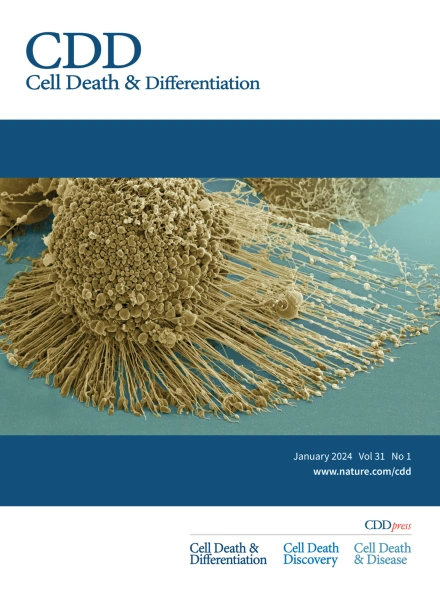S100A8和S100A9复合物调节慢性皮肤和全身炎症
IF 15.4
1区 生物学
Q1 BIOCHEMISTRY & MOLECULAR BIOLOGY
引用次数: 0
摘要
同源二聚体S100A8 (A8)和S100A9 (A9)报警蛋白及其钙保护蛋白(CP)抗菌异复合体的表达在炎症性皮肤病(ISDs)如特应性皮炎(AD)中有报道,但这种增加的功能后果尚不清楚。我们利用基因工程小鼠模型评估了A8和A9在ISD局部和皮肤外表现中的细胞和组织特异性功能。在JunB∆ep遗传AD小鼠模型中,A9或A8蛋白编码基因在表皮细胞或中性粒细胞中失活。总体而言,A9的表皮失活加剧,而类似的A8失活改善了实验ISD。当A9在中性粒细胞或所有细胞中失活时,表皮分化和皮肤炎症也得到改善。然而,A9的完全敲除与全身效应恶化相关,如中性粒细胞炎症和骨质流失。指骨远端指骨A8蛋白表达增加,SA过度生长,骨破坏。表皮A8失活改善了骨丢失,但促进了指骨破坏,可能是通过A8阳性的嗜中性粒细胞浸润。这些数据表明,位点和细胞类型特异性的A8和A9表达调节慢性皮肤和全身炎症,对皮肤分化和肌肉骨骼系统有明显的影响。这些发现为针对A8和A9不同功能的新疗法恢复表皮稳态和预防全身并发症铺平了道路。本文章由计算机程序翻译,如有差异,请以英文原文为准。


Chronic skin and systemic inflammation modulated by S100A8 and S100A9 complexes
Increased expression of the homodimeric S100A8 (A8) and S100A9 (A9) alarmins and their Calprotectin (CP) antimicrobial hetero-complex has been reported in Inflammatory Skin Diseases (ISDs) such as Atopic Dermatitis (AD), but the functional consequences of this increase are not known. We evaluated the cell- and tissue-specific functions of A8 and A9 in the local and the extra-cutaneous manifestations of ISD using genetically engineered mouse models. The genes encoding for the A9 or A8 proteins were inactivated in epidermal cells or neutrophils in the JunB∆ep genetic mouse model for AD. Overall, epidermal inactivation of A9 aggravated, while similar A8 inactivation ameliorated experimental ISD. Epidermal differentiation and skin inflammation was also ameliorated when A9 was inactivated in neutrophils or in all cells. However, complete A9 knock-out was associated with worsened systemic effects, such as neutrophilic inflammation and bone loss. In addition, the distal phalanges of the digits displayed increased A8 protein expression, SA overgrowth and bone destruction. Epidermal A8 inactivation ameliorated bone loss, but promoted bone destruction in the digits, likely through A8-positive neutrophilic infiltrates. These data show that site- and cell-type-specific A8 and A9 expression modulates chronic skin and systemic inflammation with distinct effects on the skin differentiation and on the musculoskeletal system. These findings pave the way for novel therapies targeting the divergent functions of A8 and A9 to restore epidermal homeostasis and prevent systemic complications.
求助全文
通过发布文献求助,成功后即可免费获取论文全文。
去求助
来源期刊

Cell Death and Differentiation
生物-生化与分子生物学
CiteScore
24.70
自引率
1.60%
发文量
181
审稿时长
3 months
期刊介绍:
Mission, vision and values of Cell Death & Differentiation:
To devote itself to scientific excellence in the field of cell biology, molecular biology, and biochemistry of cell death and disease.
To provide a unified forum for scientists and clinical researchers
It is committed to the rapid publication of high quality original papers relating to these subjects, together with topical, usually solicited, reviews, meeting reports, editorial correspondence and occasional commentaries on controversial and scientifically informative issues.
 求助内容:
求助内容: 应助结果提醒方式:
应助结果提醒方式:


